A star in the constellation Cassiopeia that flared into view during mid-March has erupted to naked-eye visibility. Catch it while you can!
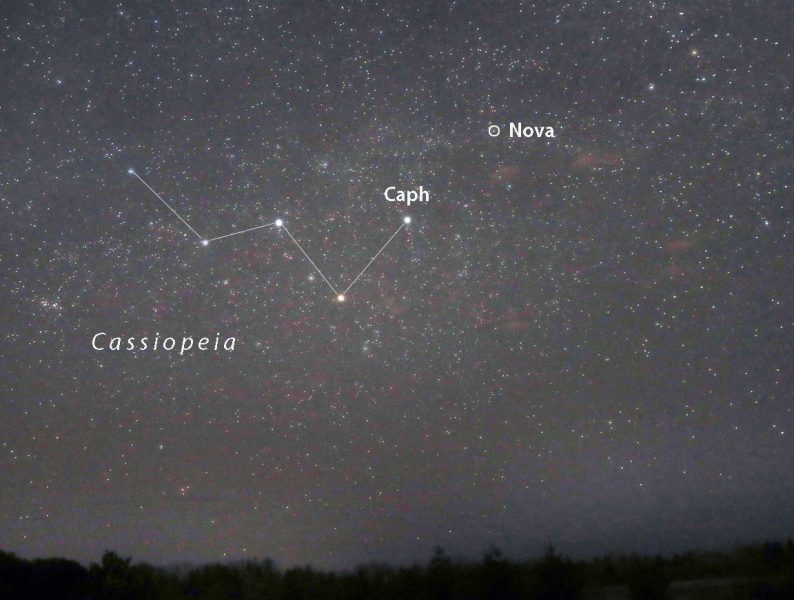
Bob King
Novae are full of surprises. When discovered at the onset of the explosion, a nova can brighten from obscurity and become visible in binoculars in a matter of hours. Some plateau and then fade. Others fade and then temporarily re-brighten one or more times before returning to their former slumbers.

Dennis di Cicco and Sean Walker
Enter Nova Cassiopeiae 2021, formally named V1405 Cassiopeiae. Discovered at magnitude 9.6 by Japanese amateur Yuji Nakamura on March 18th, it rapidly brightened to around magnitude 7.5-8.0 magnitude, then remained fairly constant in brightness for the next four weeks at magnitude 8.0. In mid-April the nova began to slowly brighten again, ending the month at magnitude 7.5.
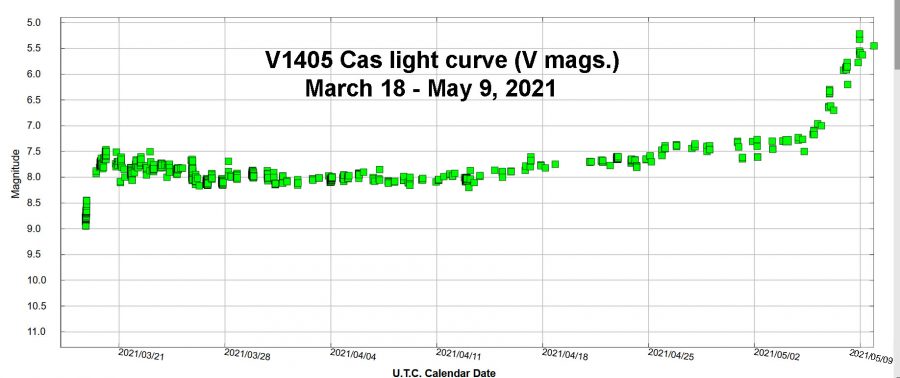
AAVSO
The big surprise came on May 6-7, when V1405 Cas did a pole vault, shooting up almost two magnitudes to 5.7! As of May 8-9, it’s still climbing, albeit more slowly. I spotted the nova without optical aid on May 9.18 UT at magnitude 5.5. At the time, Cassiopeia hung below the North Star at its nadir. At 20° altitude it appeared faint and required averted vision, but it was still a thrill to see with the naked eye. While several novae are discovered each year, bright ones are uncommon.
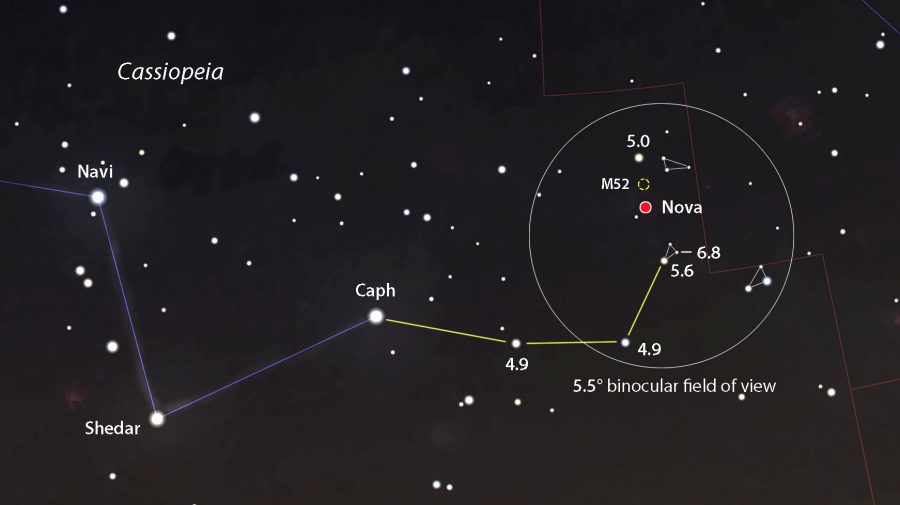
Stellarium with additions by the author
Of course, you don't have to strain your eyes if you don't want to. It's super easy to spot the nova in any pair of binoculars right now. Located near the familiar W of Cassiopeia — a circumpolar constellation from mid-northern latitudes — it's up all night from many locales.
Pre-dawn viewing is best when the nova stands highest in the northeastern sky, but as long as you have an unobstructed view to the north and see Cassiopeia, it's within reach.
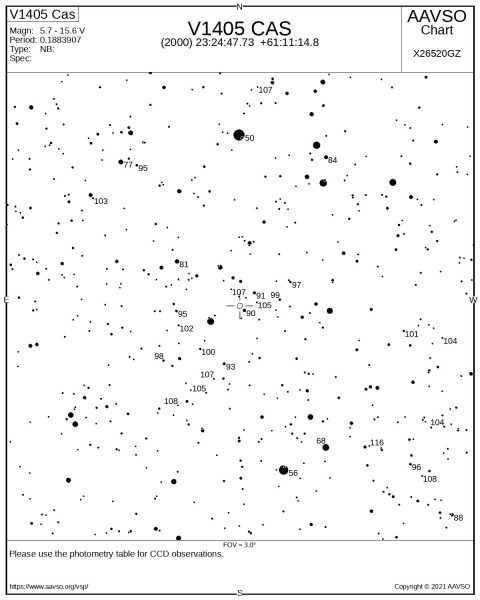
AAVSO
Start at 2nd-magnitude Caph, located at the western end of the W, and use the brighter stars and homemade triangle asterisms shown on the map as steppingstones to the nova. Just north of the nova look for a bejeweled, fuzzy patch of light, the bright star cluster M52.
According to observations reported in Astronomical Telegram 14614, V1405 Cas appears to have reached its maximum brightness. To some, the word "nova" conjures up visions of either an exploding star, after the manner of supernovae, or an old Chevy. But a nova always involves two stars in close orbit, and each goes on to live another day.
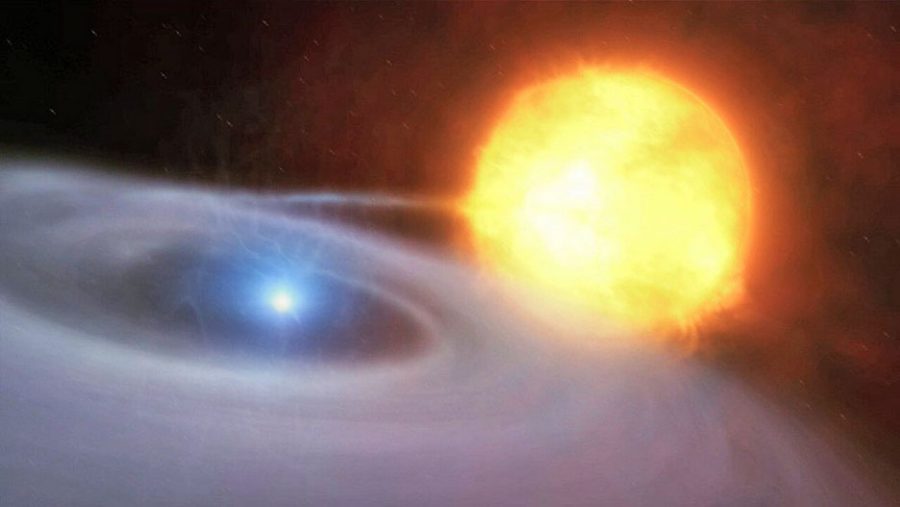
ESO / M. Kornmesser
A nova occurs when a small but incredibly dense white dwarf strips hydrogen gas from its sun-like companion. Like water going down a bathtub drain, the material spirals its way to the dwarf's surface, where it's heated and compacted by gravity until the hydrogen fuses and releases energy in an enormous explosion, much like a thermonuclear bomb. The blast brightens the star system some 50,000 to 100,00 times as the material gets shot into space at speeds of several million miles an hour.
Good thing we can watch it happen from a safe distance. For information on the nova's current brightness, pay a visit to the AAVSO (American Association of Variable Star Observers) website. Just type V1405 Cas in the Pick a Star box to see a list of recent observations or to create a chart or light curve. Have at it!
 9
9







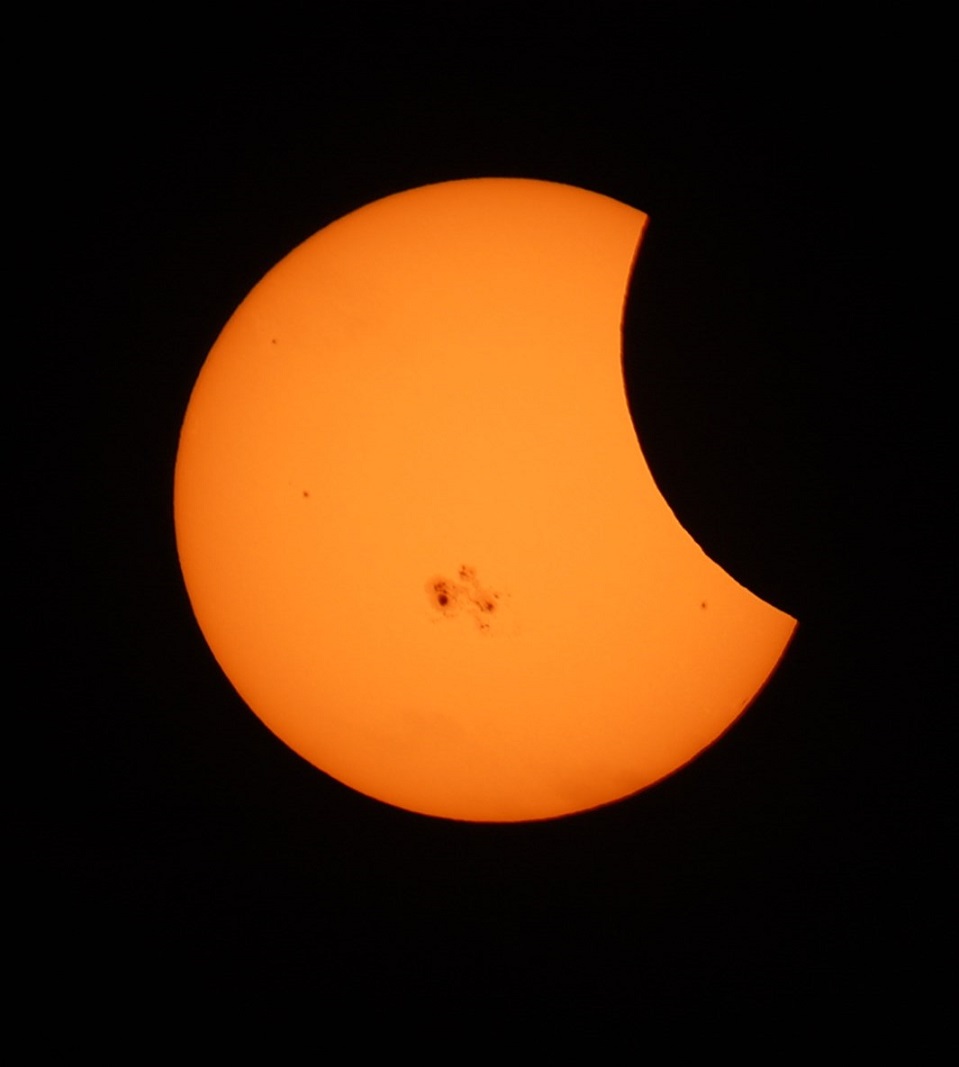

Comments
ErnieOstuno
May 11, 2021 at 5:55 pm
Very easy to find with 10x50 binoculars last night, observed at 0615 UTC May 11th from my backyard. Looked like it was fainter than 4 Cas, the mag 5.0 star north of it on the finder chart and slightly brighter than the magnitude 5.6 HD 220369 which is about the same distance south of the nova. I would guess somewhere in the range of 5.3 to 5.4 magnitude.
This isn't too far away from where the supernova of 1572 appeared. If only we could be treated to such a momentous celestial event.
You must be logged in to post a comment.
Bob KingPost Author
May 12, 2021 at 2:16 am
Hi Ernie,
Thanks for sharing your observation. That's exactly what I'm getting here — mag. 5.4 on May 11.35 UT.
You must be logged in to post a comment.
Anthony Barreiro
May 11, 2021 at 6:46 pm
I've enjoyed following this nova through 10x42 image-stabilized binoculars. Fifteen observations since March 27, when the weather has been clear and I've gotten up early. Unfortunately here in the city there's no hope of seeing stars fainter than about third magnitude with the unaided eye, but the nova is an easy find with binoculars.
I hope astronomers are studying this nova to understand why it's been so bright for so long.
You must be logged in to post a comment.
Bob KingPost Author
May 12, 2021 at 2:15 am
Excellent, Anthony! Have you submitted them to the AAVSO by chance?
You must be logged in to post a comment.
Anthony Barreiro
May 12, 2021 at 10:16 pm
I don't think the AAVSO would have much use for "still bright enough to see through my binoculars." 😉
You must be logged in to post a comment.
Dave Mitsky
May 13, 2021 at 2:59 pm
I observed V1405 Cas this morning from a fairly good dark site using Canon IS 15x50s. I didn't try to estimate its brightness but it was fainter than 4 Cassiopeiae and brighter than HD 220369 (HIP 115395). I was not able to see the nova without optical aid.
You must be logged in to post a comment.
Eric Rachut
May 15, 2021 at 6:18 pm
We have had clouds and often rain in central Texas, unfortunately, and need a break! Is the nova north or south of M52? The orientation on the photo and the orientation in the text are different.
You must be logged in to post a comment.
Bob KingPost Author
May 16, 2021 at 4:52 pm
Hi Eric,
Sorry about that. Both the photo and the map are correct and show the nova south of M52. I've corrected the text (thank you!) to reflect that. I hope the sky clears for you soon. The nova is still bright but has faded to around 6.8 as of May 16th.
You must be logged in to post a comment.
Eliot-Herman
May 28, 2021 at 12:57 pm
V1405 has undergone interesting changes, posted spectroscopy shows although the nova has faded in visual magnitude it is actually about 2X brighter in H-alpha than it was during the outburst. It has been one of the more interesting accessible events of 2021 so far to observe.
You must be logged in to post a comment.
You must be logged in to post a comment.